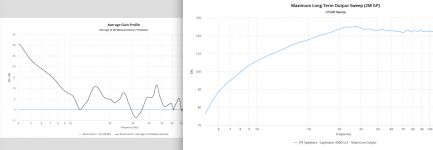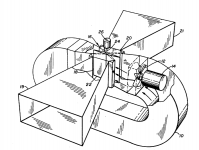Scott,Hi Art,
1)When I said that it works quite well I meant that it is working properly electromechanically.
2)I can't test its effectiveness until I place it in an infinite baffle. That said I have measured the SPL with the fan spinning at 800 rpm in neutral which is +12Db above the noise floor. Reducing that 12Db through blade design and baffle systems is what I am focusing on.
3)Only a rotary sub woofer can reproduce a significant SPL below 20Hz. Only a rotary sub can produce +100SPL at those infrasonic frequencies.
1) That is quite an achievement!
2) How loud in dB SPL (dBC or flat) is your fan at one meter, no audio input?
Everyone has their own working protocol, but prior to noise reduction pursuits it would be useful to know the output SPL, which of course will require the baffle.
3) Excursion, and VLF output has increased in transducers over the last several decades.
Josh Ricci has documented a number of subwoofers that can reproduce a significant SPL below 20Hz.
Data Bass:
dB v2
An example below, JTR's dual 18" Captivator 4000ULF can put out 100dB SPL at 8 Hz two meters outdoors, equivalent to a 106 dB 1 meter half space reference.
With 12dB room gain at 8Hz, that would be 118 dB SPL. As you can see, room gain may increase at over 12 dB per octave, so output at 5 Hz would still be above 100 Hz.
Bruce Thigpen's TRW-17 indoor measurements in a similar sized room show around 110dB down to 1Hz with maximum sound levels in the 2800 cubic foot test room of around 115-119dB, so below around 8 Hz it may have more output than a single Captivator 4000ULF.
Standard subs make no noise with no input, fans always make noise, whether contributing any signal or not.
Is high SPL below 8Hz worth the continuous noise the fan will produce at idle?
Art
Attachments
Last edited:
Art
1) Thanks!
2) C weighted at 1 metre
3) I'm impressed with Captivator's specs but it would cost me at least $4K USD to get down to 12 Hz. To get there JTR has to pump 4000 to 6000 watts into two 18 inch subwoofer drivers! With a rotary sub I can get down to 1Hz ... total investment $400 Canadian. Plus I only need 150 watts to drive it.
Scott
1) Thanks!
2) C weighted at 1 metre
3) I'm impressed with Captivator's specs but it would cost me at least $4K USD to get down to 12 Hz. To get there JTR has to pump 4000 to 6000 watts into two 18 inch subwoofer drivers! With a rotary sub I can get down to 1Hz ... total investment $400 Canadian. Plus I only need 150 watts to drive it.
Scott
Scott,2) C weighted at 1 metre
3) I'm impressed with Captivator's specs but it would cost me at least $4K USD to get down to 12 Hz. To get there JTR has to pump 4000 to 6000 watts into two 18 inch subwoofer drivers! With a rotary sub I can get down to 1Hz ... total investment $400 Canadian. Plus I only need 150 watts to drive it.
2) ?
3)The Captivator 4000ULF is a commercially available loudspeaker comparing favorably down to around 8 Hz to a commercially available rotary subwoofer transducer costing three times more even before building it's baffle and noise suppression chamber.
Any speaker can "get down to 1Hz", it's the SPL at any frequency that counts.
Until you build a baffle and measure the response, no way to know your SPL to $400 Canadian investment ratio, or the signal to noise ratio.
Art
So that thing modulates the vane angle according to the audio? Because there was a previous rotary sub, somewhat based onthe only rotary subwoofer that is commercially available. It is made by EMINENT TECHNOLOGY and costs about $20K.
US4564727A - Subwoofer speaker system
- Google Patents
where Tom Danley used a rotary motor to drive conventional cones. The motor does NOT rotate continuously, it rotates according to the audio. Later he developed one where he attached vanes directly to the motor shaft, and IIRC licensed that to Phoenix Gold which developed that into I think a spiral blade assembly. Theoretically that is better than the Eminent since you don't have a power draw to be spinning the apparatus. Of course, the devil is in the details, and sealing tips is always tough-just ask Mazda how their Wankel rotary technology is doing.
Back to Tom, what a madman, he once demonstrated to me he WAS using constantly running fans, to circulate a high speed airstream inside a mini circular wind tunnel kind of thing, with paddles to divert some of the airstream into a horn throat. The entire array was for NASA Huntsville to simulate space shuttle takeoffs, 176 dB at 3 Hz IIRC
Very cool information! I get the most fun out of the journey. If I don't quite make it to the destination I'm OK with that. I'm learning a ton of info in the process from people like yourself. Thanks for that.So that thing modulates the vane angle according to the audio? Because there was a previous rotary sub, somewhat based on
US4564727A - Subwoofer speaker system
- Google Patents
where Tom Danley used a rotary motor to drive conventional cones. The motor does NOT rotate continuously, it rotates according to the audio. Later he developed one where he attached vanes directly to the motor shaft, and IIRC licensed that to Phoenix Gold which developed that into I think a spiral blade assembly. Theoretically that is better than the Eminent since you don't have a power draw to be spinning the apparatus. Of course, the devil is in the details, and sealing tips is always tough-just ask Mazda how their Wankel rotary technology is doing.
Back to Tom, what a madman, he once demonstrated to me he WAS using constantly running fans, to circulate a high speed airstream inside a mini circular wind tunnel kind of thing, with paddles to divert some of the airstream into a horn throat. The entire array was for NASA Huntsville to simulate space shuttle takeoffs, 176 dB at 3 Hz IIRC
Scott
Head_unit,So that thing modulates the vane angle according to the audio?
Back to Tom, what a madman, he once demonstrated to me he WAS using constantly running fans, to circulate a high speed airstream inside a mini circular wind tunnel kind of thing, with paddles to divert some of the airstream into a horn throat. The entire array was for NASA Huntsville to simulate space shuttle takeoffs, 176 dB at 3 Hz IIRC
Scott (jsthomps) and Thigpen's designs both vary the fan blade angle of attack, higher amplitude audio signal increases angle of attack, increasing air flow and displacement.
Tom Danley's Servo valve loudspeaker (Patent # 5,140,641)
Servo valve loudspeaker
The "tapered horn like" structure diffuses the air from the ports into the working area, though providing "little or no acoustic loading".
Here is some information Tom wrote about it, circa 1998:
“In my work developing transducers at Intersonics Inc, I have built
devices and systems to produce high sound levels at both ends of the
spectrum. One sonic boom simulator supplied to BBN could produce 163 dB
at 5 HZ (in a concrete bunker) and could remove windows and doors from
there frames and fixtures.
Another sonic boom simulator (3 way system called "speakers from hell"
on "beyond 2000" TV show) had the displacement of an 8 foot by 12 foot piston
moving 18" peak to peak, the system could produce >132dB on the outside wall
of an old house from 3HZ to 5KHZ.
This is about 2 lb pressure acoustic pressure per sq ft and with a sine
wave at 3 HZ, made the middle of the wall move 8-10 inches in and out
and "house parts" frequently would fall off (I thought we broke the
house at one point when there was a loud crash from the crawl space so
we stopped "teasing" the house with the oscillator).
In testing, I intentionally experienced many slow TEF sweeps from 28
down to 3 HZ at full intensity (cause I'm a bass sicko) with never the
need to change underwear. Certainly there was a strong feeling of relief
when it stopped but it had no other Ill effect. BTW at 3 HZ the
threshold of audibility is about 125 dB so at 132 dB 3 HZ IS audible! I
felt fairly safe exposing myself to this as I had found a very good book
on the subject called "Infrasound and Low Frequency Vibration" edited by
W. Tempest, published by Academic press.
Regards,
Thomas Danley”
As it only takes about 105 dB at 15 Hz to start to "flap" 5/8" drywall on 2x4", one must be prepared for structural damage if sustained high SPL VLF tones are achieved.
Art
Attachments
- Status
- This old topic is closed. If you want to reopen this topic, contact a moderator using the "Report Post" button.
- Home
- Loudspeakers
- Subwoofers
- Rotary subwoofer baffle system

